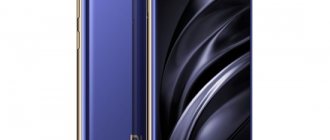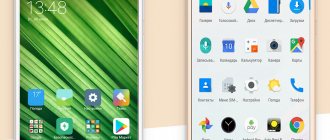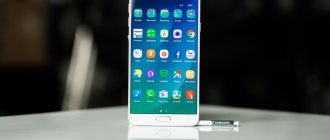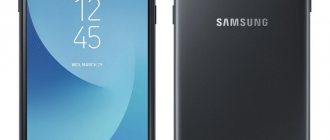Description of Xiaomi wireless charging
Wireless charging of the Wireless Charging model is a panel that transfers energy to the gadget that is located on it. The device itself is powered from the mains. There are also models that work as a powerbank: an integrated battery allows you to use the device without being tied to a power source. Such a device will help out in the car, in nature, in an emergency. The only thing that is required of the owner is to charge the drive in a timely manner.
The operating principle of the module is to propagate current over short distances by an electromagnetic field. The charger (CH) contains a transmitting coil with a control circuit. The receiving coil is located in the smartphone. The induced alternating current is converted by the receiver circuit into direct current, with the necessary parameters, and supplied to the battery.
Most Xiaomi charging stations have a round contact surface made of rubberized plastic. On the back side there are ventilation holes that provide forced circulation of cooling air.
The cooler located inside the case effectively cools the device, but produces noise that is clearly audible in a small room. The station is connected to the power source via a USB Type C connector. Brief technical data and additional information are printed on the bottom side of the unit.
In addition to chargers, Xiaomi produces wireless mice Mi Wireless Mouse, equipped with the Qi standard, and mouse pads for them. The device is equipped with a smart multifunction button, with which you can adjust the PC sound, and have a constantly charged smartphone at hand.
Xiaomi Mi 9 6/64GB – a powerful phone without any flair
Xiaomi Mi 9 has everything that is best in devices in its price category, but is nothing special among its competitors.
SuperAMOLED from Samsung with a diagonal of 6.4 inches with a resolution of 2340x1080 pixels supports HDR, which almost no one uses. Viewing angles are decent, and the brightness is not enough to keep the image easily readable in the sun.
The 3300 mAh battery can last up to 10 hours in games at peak display brightness with communications turned off. And the case hardly gets hot.
Mi 9 uses productive and energy-efficient hardware. The 7-nm processor from Qualcomm is distinguished by its Prime Core core distribution algorithm, which makes power consumption very economical. There is only one productive core.
Adaptive mode also does its job. To replenish the charge, QI and 20W fast charging are supported. The only thing that can distinguish Mi 9 from the mass of analogues is the Hexagon 690 SDP processor.
The camera is represented by 48, 12 and 16 megapixel modules, and has laser focusing. In the evening, the photo quality suffers from insufficient detail and noise. Video shooting is carried out in 4K resolution at 60 fps.
Pros:
- Laser autofocus system.
- Fast charging QC4+.
Minuses:
- Unfinished camera software.
- Backlash in the rear wall of the case.
- The battery runs out quickly.
- The screen flickers noticeably.
Device characteristics
Characteristics of Xiaomi.
To comply with the Qi power standard, the device must have the following characteristics:
- voltage - 5 V;
- current strength - 1-2 A;
- power - up to 5, 10 and 15 W.
A protocol is provided between the base and the smartphone, with the help of which the charger receives data on the charge level and remaining capacity of the battery of the connected device.
Based on the information received, the amount of transmitted current is determined and the adapter automatically turns off when the battery is fully charged.
Some models, such as the ZMI WTX 10, support the function of identifying the presence of foreign metal objects on the contact surface of the docking station. If they are detected, the charger will immediately turn off.
Appearance and Design
In most cases, the wireless charging base is made of polished aluminum and has a round shape. Car charging systems come with smartphone mounts, but the charging module has a similar shape. The color of the gadget can be matched to the phone. To prevent the device being charged from slipping on the contact surface, it is covered with a thin layer of rubber or an anti-slip ring is used.
On the side rim there is an LED indicator and a connector for connecting to the network, which organically fit into the overall appearance of the design and do not draw attention to themselves. The product is made in an ergonomic style and fits any room or workplace design.
iPhone 11 or iPhone 11 Pro
iPhone 11, 11 Pro and 11 Pro Max
✅Pros:
- Premium build quality and materials
- Software updates for 4 years
- Gorgeous cameras + the ability to shoot 4K/60 FPS on all cameras, including the front one
- OLED screen with HDR10 and Dolby Vision (11 Pro only)
- The best hardware even among 2020 chips
- Water protection
- Fast and wireless charging, finally high autonomy
⛔Cons:
- Very expensive
- No memory card slot and 3.5 mm jack
- You cannot insert 2 SIM cards, there is e-sim support, but the technology is not used in Russia
Follow the links - review of iPhone 11 and 11 Pro
Please rate the article:
Terms of use
Rules for using the charging system.
If the charging system is connected to a power source via an adapter, then it is necessary that the input parameters of the supply network correspond to the parameters specified by the manufacturer.
For example, if the converter says Input 5 V 2 A, then when you connect the device to a PC, the charge will not flow, since the USB output current does not exceed 0.5-1 A.
To charge your mobile phone, you need to follow these steps:
- Connect the Qi system to the network using the supplied device.
- Place the charging station on a flat surface or other place recommended by the manufacturer depending on the shape and type of gadget being charged.
- Place the smartphone on the module platform with the screen facing up. To speed up charging, the center of the phone must be in the marked area.
- Make sure that the smartphone has started charging. This will be indicated by the corresponding sign, and an icon in the form of a lightning bolt will appear on the screen.
Capacity restoration will begin automatically a few seconds after placing the mobile phone on the surface of the charger. When fully charged, the module will turn off on its own.
Adding wireless charging to the Xiaomi Mi6 smartphone - cheap and cheerful
A short review of the receiver-transmitter for adding Qi wireless charging to any smartphone. In my case, it will be the cheerful old Xiaomi Mi6
My Xiaomi Mi6 is already over a year old and everything is complicated with it, as well as with the issues of choosing a smartphone in general. Sometimes it seems to me that it’s time to change it to a newer model, and at the same time, new products in the middle price range are either weaker than it or do not arouse interest. The Huawei 20/30 Pro was of interest, but then the latest news about the failure of Google services to work on Huawei devices (mail/playmarket/youtube) is no longer an option. My connector is also a little loose and the battery is clearly not the same as it was originally - a consequence of hyperactive use, when the smartphone goes through 2-3 charge-discharge cycles per day. I’m constantly filming something, constantly taking photos (it’s all uploaded to the cloud), reading a lot and making many, many calls.
For a long time I thought about adding wireless charging to my smartphone, it would solve many of my problems. And with a connector, and with constant charging and with the ability to use SUDDENLY without poking the cable every time.
I ordered it without much choice on the market from one seller and so that there were inexpensive lots of charging and a Qi wireless charging receiver for the Type-C connector. It was around the end of March and coupons could make such a joint purchase more interesting.
Let's start with charging - there are many, many of them on the market now, but not all are equally useful (c). This one supports fast charging, but has a micro-USB output.
A funny, slightly steampunk design in the form of open “windows” to the board and ADD lighting. It turns out that during the charging process, the LEDs light up in a circle and very clearly signal the progress of the charging process. When finishing or if the smartphone is poorly placed on this site, the LEDs do not light up and sales are noticeable from the other end of the room, even with vision problems.
The second necessary part is the receiver, which is connected to the transmitter and uses a cable to occupy the type-c port of the smartphone. Here, too, variability is possible and you can choose a 2A transmitter, but it will heat up twice as much and heat the battery inside. And summer is ahead, and my battery doesn’t last as long as it did initially.
Once upon a time I stocked up on cases for Xiaomi Mi 6 for a couple of bucks and used Nillkin for a long time - I highly recommend it by the way, it was already cracked from numerous falls, but the smartphone saved me more than once. But now I changed it to just a silicone one with a print, so that I could stuff the successor under it and at the same time all this would not be visible through the case itself. The cable is connected to the smartphone port and that’s it, M-Magic!
The specifications state that it works with any cases up to 5 mm thick (has anyone seen cases this thick?).
Surprisingly, with the stated 5V1A, the successor can also work with QC - the smartphone is half charged and draws 6-7 watts, the current varies depending on the selected operating mode of the source. So, with my idea of leisurely charging and minimal heating, it didn’t work out very well, although it doesn’t heat up more than the conventional 40 degrees (according to CPU-Z, the battery temperature is generally 35-37 degrees, if we consider its information correct). I did not see any notifications about overheating or charging stopping. At the same time, I once saw this when in a hot country I tried to charge a smartphone via QC and it was very against it.
Below is a short video review and exactly what I was talking about happened there - a smartphone on charge and an incoming call (some bank spammers called, we have money just for you, well, take it, please).
So, for little money you can make any smartphone the owner of wireless charging and thus try to solve the issue of its initially missing functionality. The main idea is that there are plenty of similar lots on Aliexpress, but who is interested in exactly those appearing in the frame:
– charging – $10.85 at the time of writing these lines – https://ru.aliexpress.com/item/32977447566.html
– successor – $3.94 at the time of writing these lines – https://ru.aliexpress.com/item/32974425164.html
And finally, I would recommend using EPN cashback - the most profitable cashback for Chinese shopping. And do not lose the opportunity to return about 5-10% of the money spent on Aliexpress and in Chinese stores (now on Gearbest EPN generally gives an excellent return percentage, but this is temporary). That is, for a total of 100 bucks spent on Ali on different products and different orders, the total cashback will return about 5-10 dollars, sometimes even more. And the final price for all of them will no longer be 100, but 85-90 bucks. Here is the invitation link with all the details - https://cashback.epn.bz/?i=41c2a
23.05.2019 @ 17:10
Chargers, power banks, solar panels, Phones, cases and accessories
aliexpress, aliexpress
Basic modes
Due to the fact that most cheap chargers have one transmitting coil, the quality of replenishing the battery capacity largely depends on the location of the mobile device relative to it. A shift from the center of the emitter even by half the diameter will not allow the process of charge restoration to begin due to the impossibility of recognition, determination of the residual capacity and the value of the charging current.
Data exchange between devices is carried out using the Qi standard, which is capable of transmitting information at speeds of up to 2 kbit/s. The process occurs continuously and is used not only to check the compatibility of standards, but also to set different modes or terminate an operation.
If the distance between the surfaces of the devices is less than 4 mm and there are no shielding materials between them, charging will start automatically. If the temperature rises above the permissible level, the docking station will turn off. When the full capacity is reached, the process will automatically stop and the gadget will turn off power.
Charging speed
Charge replenishment speed.
The charge replenishment speed depends on the power of the charger, that is, on the output voltage. Since the current value is constant and amounts to 1 or 2 A, then by increasing the voltage at the module output, you can increase the power of the docking station.
The output parameters of the MDY-10-EH 20 W model are:
- 5 V - 3 A;
- 9 V - 3 A;
- 12 V - 2.25 A;
- 20 V - 1.35 A.
The voltage value is selected automatically during data exchange. The manufacturer claims that the operation speed complies with the Quick Charde 3.0 standard.
The following results were obtained during testing:
- 30 minutes - 46%;
- 1 hour - 79%;
- 1 hour 30 minutes - 100%.
For comparison, the wireless bundled device for Xiaomi Mi5 with a power of 7 W takes 2.3 hours to fully charge. But for most commercial wireless docking stations, this parameter is comparable to wired storage, and in some cases even lower.
Honor V30 Pro
✅Pros:
- Huawei's latest flagship with Android 10
- Powerful Kirin 990 processor
- One of the best cameras on the market – DxOMark confirms
- 4100 mAh battery + fast, reverse and wireless charging. Moreover, the fast charging speed is impressive - 70% in 30 minutes; fast wireless charging speed – 52% in 30 minutes
- Fast UFS 3.0 memory
- Low price tag
⛔Cons:
- No water protection
- IPS screen with limited contrast; competitors have more advanced OLED matrices
- There is no support for Google services, including the Play Store, but there are analogues: AppGallery, Amazon AppStore
- No memory card slot or headphone jack
Follow the link to find a review of Honor V30 Pro; for your money - a very cool option.
List of smartphones with wireless charging function
When wireless charging appeared, the innovation was introduced only on flagship and expensive models. Now this is an affordable technology that allows you to use it for almost all devices. The exception is models made in a case with a metal back cover. Smartphones without a built-in NFS module can be installed in the form of a case with a transmitting coil or a similar back cover.
Among Xiaomi smartphones, the following models are equipped with wireless charging:
- Mi Note 2;
- Mi Note 3;
- Mi Mix 2;
- Mi Mix 3;
- Mi 5;
- Mi 5s;
- Mi 6;
- Mi 9.
Other manufacturers (Samsung, LG, Motorola), in addition to the Qi protocol, use the PMA standard. It is almost unknown to European consumers, but is widely used in North America, with some chain establishments (Starbucks) integrating wireless PMA systems into table tops.
Huawei P30 Pro – the best in terms of price/quality ratio
Huawei P30 on the left and P30 Pro on the right
✅What's good:
- OLED screen with HDR
- Water protection
- The best camera among smartphones under 45 thousand
- Large 4200mAh battery + 40W fast charging (70% in 30 minutes) + wireless charging
- Powerful Kirin 980 processor that handles everything
- Awesome telephoto camera with 5x optical zoom
⛔What's bad:
- No headphone jack
- Memory UFS 2.1, many competitors have UFS 3.0
- The cutout in the screen for the front camera looks so-so
- No stereo speakers - some competitors have
Even taking into account the shortcomings, the Huawei P30 Pro is a chic camera phone that focuses on photo quality first and foremost. Wireless charging is a bonus. Follow the link - review of Huawei P30 Pro
Range of wireless chargers
RM60 Mi Wireless.
Each company strives to produce wireless chargers of the same brand. Xiaomi is no exception in this matter. However, this does not mean that charging the corresponding devices is allowed only with the included charger. Other stations with suitable parameters can be used.
Xiaomi has released the following wireless platforms for its products:
- RM60 Mi Wireless Charge;
- Xiaomi Wiraless Charger pad VH101;
- ZMI WTX10;
- MDY-09EF;
- 70Mai Car Wireless Charger.
The latest charger is a hybrid of a charger and a universal smartphone holder and receives power from the cigarette lighter. Most devices can be completely autonomous (have a built-in battery) or connected to a power bank.
Advantages and disadvantages
In their reviews, users note both positive and negative aspects of the wireless system.
The advantages of the gadget are:
- ease of use;
- Can be used as a stand or holder;
- the ability to distinguish foreign objects on the contact surface;
- increasing the operating time of the smartphone's power connector.
Flaws:
- low charging speed;
- large size compared to the network adapter;
- low functionality of the smartphone while charging.
When a mobile device is on the platform, it is impossible to answer a call or view the necessary information without interrupting the process. On the other hand, this reduces power consumption and does not increase the temperature of both devices.











